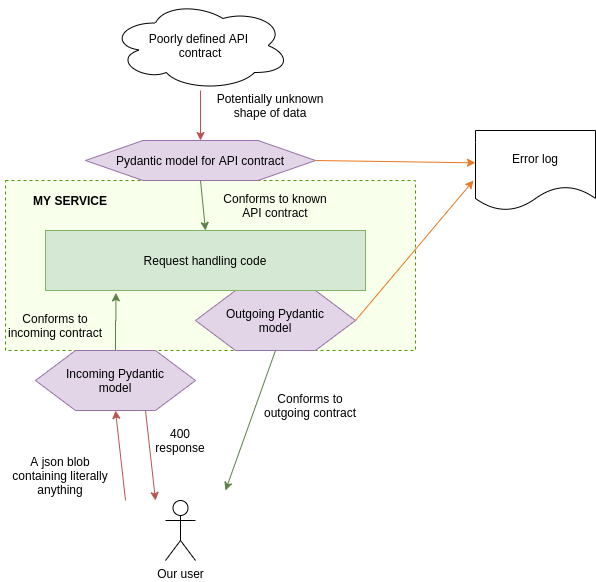Types at the edges in Python
For a new web service in python there are 3 things I now often start with:
Why
This main reason for this is because I don’t like errors like this:
AttributeError: 'NoneType' object has no attribute 'strip'
It’s hard to understand. Why am I trying to strip whitespace from None? How did I end up in this part of the code? What have I misunderstood?
Instead I would prefer to see something like this error:
1 validation error for ProductDetails
description
none is not an allowed value (type=type_error.none.not_allowed)
Now I can see that when getting ProductDetails the value description
which I’d assumed was always populated is None. It’s much easier
for me to see what about my mental model was wrong with this error.
How Pydantic helps
When integrating an API we read the documentation.
We check the contracts provided. We use any test services available.
After this process we have some client code with a bunch of (somewhat)
tested assumptions. We then launch this code into production and our
assumptions are tested against reality. If we’re lucky our assumptions
turn out to be correct. If not we likely encounter some
cryptic NoneType errors like the one at the start of this post.
Pydantic can help by formalising our assumptions. For example imagine a call to an API to get details about a product for a webshop of some kind:
def get_product_details(pid: str):
"""
A dictionary with the product details:
in_stock - bool
name - str
description - str
"""
resp = requests.get(f"https://shopping.com/product/{pid}")
return resp.json()
with Pydantic I could instead write the function as:
class ProductDetails(BaseModel):
in_stock: bool
name: str
description: str
def get_product_details(pid: str) -> ProductDetails:
resp = requests.get(f"https://shopping.com/product/{pid}")
return ProductDetails(**resp.json())
Pydantic checks that each key I expected exists and is of the correct type. So now all the assumptions I’ve made about the shape of the data is a runtime contract, expressed in native python. If in production it turns out that description is, in fact, optional I’ll get a very descriptive error and the code will fail early.
How mypy carries on helping
Once I see the error at the start of this post (thanks error reporting) I know what is wrong about my assumptions and I make the following change to my code:
class ProductDetails(BaseModel):
in_stock: bool
name: str
description: typing.Optional[str]
I run mypy next and get:
product/details.py:63: error: Item "None" of "Optional[str]" has no attribute "strip"
I go to this line and them remember that I wrote a function to tidy the whitespace a little:
def tidied_up_description(details: ProductDetails) -> str:
return details.description.strip()
now I can make mypy pass by dealing with the new None case:
def tidied_up_description(details: ProductDetails) -> str:
return (details.description or "").strip()
All of this flows automatically by stating and then updating my assumptions in the form of a Pydantic model. Once I’ve updated this and any other errors I deploy my changes. Hopefully now we’ll have a system running error free.
Request validation
I can also apply exactly the same kind of logic on data coming into my system. For example let’s look at a POST endpoint for ordering a product in my webshop (I picked FastAPI but you could choose anything really):
class ProductOrder(BaseModel):
product_id: str
quantity: int
@app.post("/order/")
async def add_item(order: ProductOrder):
# Do something with order
return "ok"
FastAPI was used as it integrates with Pydantic out of the box but, again, this could be built with any framework. The post data gets loaded automatically into this Pydantic model (thanks to FastAPI). Any validation errors will result in a 400 error being returned to the browser. An added benefit of Pydantic is that json schemas can be generated for each model so we can communicate our requirements in a platform neutral fashion.
We can also do exactly the same with the data leaving our system so any consumers of our API can rely on the schema we’ve given them.
The big picture
Once all API communication is type checked, and all our incoming requests go through our models then we’ll have a system something like this:

Everything within the green box has a well known shape. It’s much easier to reason about and static analysis can help spot bugs early. Hopefully this post has given you a sense of why I think this is so powerful. If you’d like to try out an example of how this can help I’ve written a mini-kata like exercise here that can be worked through: meadsteve/types-at-the-edges-minikata